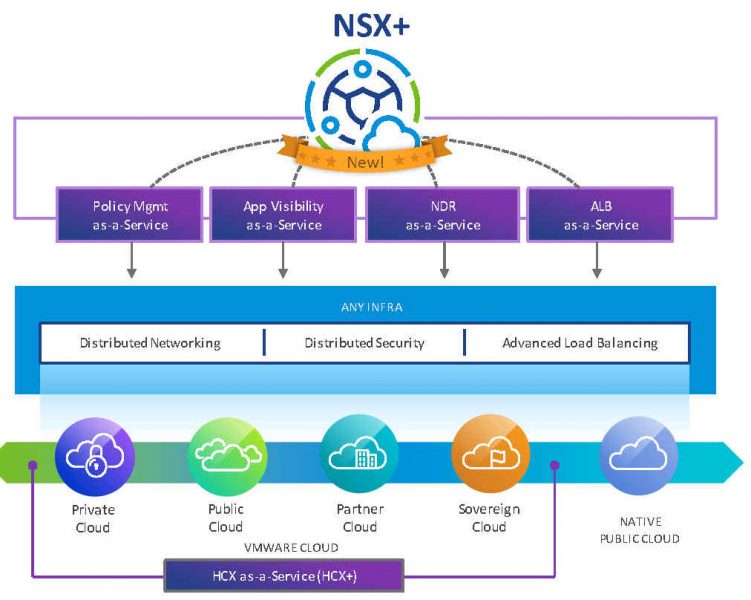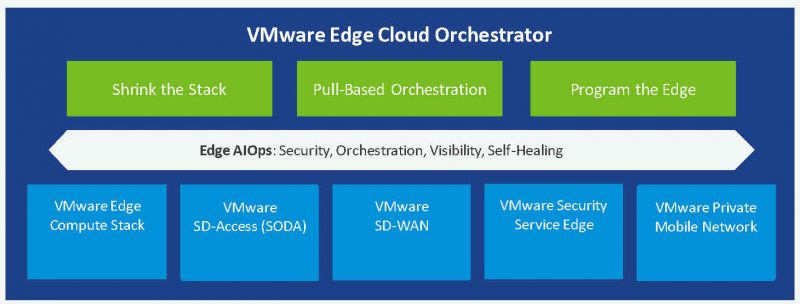 CLOUD
CLOUD
 CLOUD
CLOUD
 CLOUD
CLOUD
VMware Inc. is kicking off its annual Explore user conference today with a bushel of new and enhanced products designed to simplify multicloud management, support evolving edge use cases and streamline the administration of end-user computing environments.
VMware Cloud, which combines the company’s Cloud Foundation software and Cloud Services, is being repackaged into five editions — Essentials, Standard, Pro, Advanced and Enterprise — that span the stages of cloud adoption in enterprises. The intent is to provide ”a prescriptive pathway for customers to buy and consume VMware cloud based on where they are in the journey to modernization,” Prashanth Shenoy, vice president of cloud platform, infrastructure and solutions marketing, said in a press briefing.
The Essentials Ddition packages virtual machines and software containers with cloud services and workload management. The Standard edition adds integrated computing and storage in a hyperconverged infrastructure platform with operations management. The Pro edition adds high-performance storage.
The Cloud Advanced Edition comes with full-stack hyperconverged infrastructure encompassing computing, storage, networking and management, integrated lifecycle management and on-premises cloud infrastructure. Cloud Enterprise is the highest-level package, with storage encryption and site reliability engineering services. All three can be managed either on-premises, as a VMware-managed cloud service, or by third-party service providers such as IBM Corp.
“VMware customers report challenges with existing licensing models, including complexity that creates confusion and uncertainty,” said Andrew Lerner, a distinguished vice president at Gartner Inc. “Any attempt to simplify and streamline licensing likely will resonate. That said, it is too early to say whether this is a moderate incremental improvement or a dramatic improvement.”
The Cloud Foundation component of VMware Cloud is getting a number of performance and capacity boosts, including a tenfold increase in the number of tasks that can be executed simultaneously and double the graphics processing unit capacity. Upgrade times have been cut by a third and workload domain capacity boosted by 60%.
The enhancements are intended to address the competing priorities information technology organizations are encountering to develop applications faster while also controlling cloud spending, Shenoy said. “We are evolving our VMware cloud portfolio to provide a single multicloud infrastructure as a service platform so they can deploy their applications wherever they want using a consistent infrastructure and operating model,” he said.
Furthering the multicloud theme, VMware is extending its NSX multicloud networking software with a new cloud-managed service offering for multicloud environments called NSX+. The software-as-a-service service supports a single cloud operating model with zero-trust security and consistent networking and security across VMware Cloud environments. It allows for centralized security policy creation and enforcement, full network and application visibility, and network detection, VMware said.

NSX+ Multi-Cloud Networking and Security Services Image: VMware
“Eighty percent of organizations have a multicloud strategy,” said Umesh Mahajan, senior vice president and general manager of the networking and security business unit. “Networking is the glue that ties it together.”
NSX+ virtual private clouds add full isolation of networking, security and services to multiple tenants on a shared VMware Cloud infrastructure with self-service provisioning managed by a single NSX instance.
The offering is intended to address the security gaps that multicloud environments create, said. “It provides comprehensive visibility into applications’ security posture regardless of where they’re deployed,” Majahan said.
There are four core services in NSX+. Policy management is said to enable policies to be consistently enforced across multiple clouds from a single console and speeds up cross-cloud application and network deployment. Unified application visibility identifies security gaps across multiple clouds and provides visibility into applications and security regardless of where they are deployed.
Network threat detection reduces the risk of ransomware by identifying “emerging threats that could become full-blown intrusions,” Mahajan said. Advanced load balancing is an automated service for rapid application deployment with transaction visibility so problems can be diagnosed quickly. It’s available on VMware Cloud and Amazon Web Services Inc. infrastructure-as-a-service. Existing NSX users can migrate to the expanded platform via a software update.
Gartner’s Lerner said the new offering is “a more robust investment from VMware in terms of feature capability and focus,” but that the multi-cloud networking software market as a whole has underperformed expectations. “Some of the barriers to entry for customers are that the native offerings from cloud providers are seen as good enough, it is hard to justify the return on investment and the cutover to MCNS is tedious,” he said. “As a result, MCNS vendors struggle fiercely to expand their business.”
VMware Cloud storage is getting scalability and cost-efficiency upgrades with vSAN Max, a new offering within the vSAN storage area networking line that delivers up to 8.6 petabytes of disaggregated storage with a single administration point. Storage can be scaled independently from computing for better utilization and can support up to 3.6 million inputs/outputs per cluster, VMware said. It can withstand failures across sites and hosts and can heal itself up to 92% faster than previous vSAN versions, according to company data.
“We’re seeing an explosion of data and new technologies like AI that require a new approach for storage-intensive applications where customers can independently scale the storage clusters from their compute clusters,” Shenoy said. He said early vSAN Max customers have seen operational cost savings of as much as 30%.
New ransomware recovery capabilities allow for concurrent multi-VM recovery operations and the ability for customers to run production workloads in the cloud until forensics are completed and protections established. VMware also unveiled a technology preview of secure storage that integrates recovery workflows with native vSAN snapshots for data transfer optimization.
With International Data Corp. expecting worldwide spending on edge computing this year to grow 13%, to $208 billion, VMware is introducing new and enhanced orchestration capabilities for the edge that is says help IT organizations to better match workloads with computing capacity.

Image: VMware
“Because the edge is stretched across so many locations, full synchronization is critical so you can get asynchronous behavior combined with installation and maintenance done with precision,” said Sanjay Uppal, general manager of service provider and edge business. “When workloads match with the network, magic happens.”
Edge Cloud Orchestrator, which was formerly called VMware SASE Orchestrator, will provide unified management for VMware secure access service edge and the VMware Edge Compute Stack. SASE is a converged network and security service that includes software-defined wide-area networking and cloud native security functions.
Enhancements to the orchestrator are said to help customers plan, deploy, run, visualize and manage their edge environments based on business outcomes with a single console to manage edge infrastructure, networking and security. The approach is based on shrinking the stack to the smallest possible footprint with security and administrative updates “pulled” by the workload along with network programmability in code.
The company also unveiled new orchestration capabilities for the VMware Edge Compute Stack based on Project Keswick, an effort to optimize endpoint deployment through automation in code. It combines pull-based configuration with zero-touch provisioning and desired state management principles as defined by the GitOps operational framework for infrastructure automation. Users can automate security updates across edge infrastructure and ensure that updates are applied to edges that lack a stable inbound network connection.
Finally, VMware is integrating artificial intelligence features into its Anywhere Workspace platform, a cross-cloud services portfolio that covers digital employee experience, virtual desktop infrastructure, unified endpoint management and security.
The improvements are meant to address growing pressures on support organizations to accommodate variable work schedules, support a profusion of devices and ensure security with a distributed workforce, said Renu Upadhyay, vice president of product marketing for the end-user computing business unit.
“It’s about allowing IT to do more with less by allowing the platform to be self-configuring, self-healing and self-securing to make it easier to support employees with a scalable approach,” she said.
Digital Employee Experience, a software platform that monitors user experience and helps remediate problems, can now monitor seasonal variations and monitor the availability of the SaaS applications employees use. The workspace suite can also now deliver application performance scores in addition to existing mobile, desktop and virtual environment experience scores. If a SaaS service goes down, IT and affected employees can be automatically notified.
Playbooks, which are step-by-step guides to proactive problem resolution, now include machine learning algorithms and expanded access to help data. IT administrators can create step-by-step remediation workflows and use success rate analytics to automate the resolution process and streamline execution over time through machine learning.
An expanded partnership with Intel Corp. will integrate VMware’s Workspace ONE with Intel vPro, a microprocessor optimized for remote management and security. The integration should make it easier for IT organizations to secure and remotely manage devices entirely from the cloud with no additional on-premises infrastructure or management software needed, VMware said.
Intel vPro provides centralized visibility into PCs, rapid patch remediation and remote diagnosis and repair. The capabilities complement an expansion of VMware App Volumes to enable support teams to deliver applications to persistent virtual desktops from VMware, Citrix Systems Inc., Microsoft Corp. and Amazon.
Most of the enhanced products will become available during the third and fourth quarters.
Support our mission to keep content open and free by engaging with theCUBE community. Join theCUBE’s Alumni Trust Network, where technology leaders connect, share intelligence and create opportunities.
Founded by tech visionaries John Furrier and Dave Vellante, SiliconANGLE Media has built a dynamic ecosystem of industry-leading digital media brands that reach 15+ million elite tech professionals. Our new proprietary theCUBE AI Video Cloud is breaking ground in audience interaction, leveraging theCUBEai.com neural network to help technology companies make data-driven decisions and stay at the forefront of industry conversations.